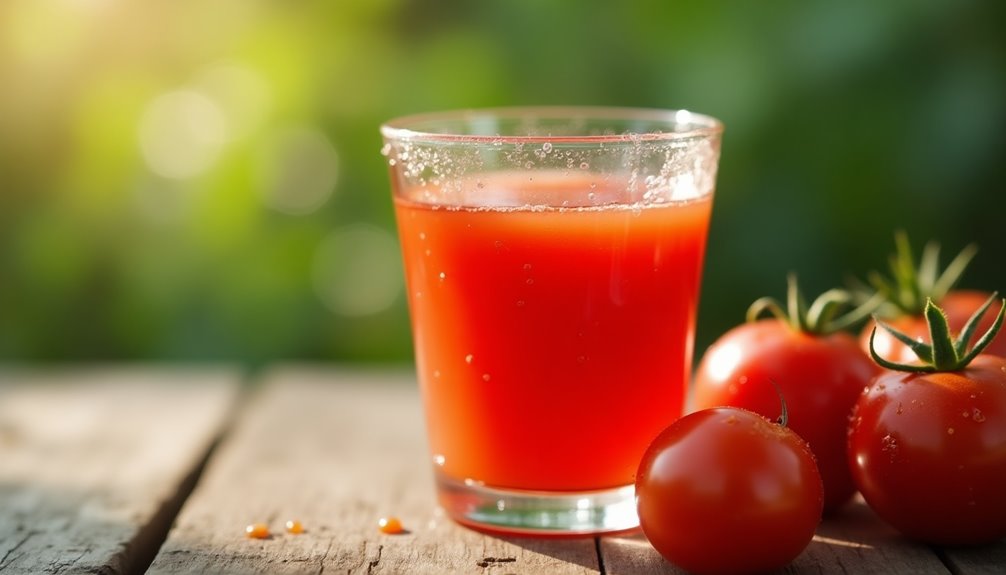Tomato juice typically has about 41 calories per one-cup (240 ml) serving, making it a great low-calorie drink choice. Most brands offer options with 100 calories or fewer per 8 fl oz, so you can enjoy it guilt-free. It's packed with essential vitamins like vitamin C, plus potassium and folate for added health benefits. Keep an eye on added sugars, as some brands maintain natural flavors without them. There's much more to explore about tomato juice's benefits!
Key Takeaways
- A typical one-cup (240 ml) serving of tomato juice contains about 41 calories.
- Most brands offer servings with 100 calories or less per 8 fl oz.
- Calorie content can range from 35 to 100 calories depending on the brand.
- Tomato juice is a low-calorie beverage that is nutrient-dense and hydrating.
- Many brands focus on natural flavors with minimal added sugars to maintain lower calorie content.

Have you ever wondered how many calories are in tomato juice? You might be surprised to learn that a typical one-cup (240 ml) serving of this delicious beverage contains about 41 calories. This makes it a low-calorie choice, perfect for anyone looking to enjoy a flavorful drink without adding too many calories to their daily diet. Most brands, including popular ones like Campbell's, offer servings that contain 100 calories or less per 8 fl oz. So, you can sip on tomato juice guilt-free while still keeping your calorie count in check.
The calorie content in tomato juice can vary slightly between brands, generally ranging from 35 to 100 calories per serving. Regardless of the specific formulation, you can rest assured that this beverage remains a low-calorie option.
While it's true that tomato juice isn't a significant source of fat or protein, carbohydrates make up most of its calorie content. However, despite its low-calorie nature, tomato juice is nutrient-dense, providing essential vitamins and minerals that contribute positively to your nutrition.
One of the standout features of tomato juice is its impressive vitamin C content. This vitamin is crucial for maintaining a healthy immune system and supporting skin health. When you drink tomato juice, you're not just quenching your thirst; you're also boosting your intake of this vital nutrient.
In fact, the Daily Value (DV) for vitamin C tells us that just one serving of tomato juice can cover a substantial portion of your daily requirement. This makes tomato juice a fantastic addition to your daily diet, especially if you're aiming to up your vitamin intake.
Another important aspect to consider when drinking tomato juice is the presence of added sugars. Many brands keep their formulations simple, focusing on the natural flavors and nutrients found in tomatoes without relying on added sugars. This is a significant benefit, as added sugars can increase the calorie content and contribute to unwanted weight gain.
By choosing tomato juice with minimal added sugars, you're making a smart choice for your health.
Incorporating tomato juice into your daily diet can also provide a variety of other nutrients. Alongside vitamin C, you'll find potassium and folate, which are essential for various bodily functions.
This means that even though you're consuming a low-calorie beverage, you're still reaping the benefits of numerous vitamins and minerals that support your overall health.
Frequently Asked Questions
Can I Drink Tomato Juice for Weight Loss?
Yes, you can drink tomato juice for weight loss. It's low in calories and packed with nutrients like vitamin C and potassium, making it a smart addition to your diet.
The high water content helps keep you hydrated and can curb hunger, aiding in appetite control.
Plus, incorporating it into your meals enhances flavor without adding too many calories, supporting your weight management goals while promoting overall health and wellness.
How Many Calories in a 8 Oz Glass of Tomato Juice?
Picture your taste buds dancing as you sip a refreshing glass of tomato juice.
In an 8 oz serving, you're looking at roughly 35 to 100 calories, depending on the brand and any added ingredients.
For a guilt-free option, brands like Sacramento offer around 46 calories when adjusted to 8 oz.
With its low-calorie content, tomato juice can be a smart choice for your diet while still satisfying your cravings.
Enjoy!
Is It OK to Drink Tomato Juice Every Day?
Yes, it's generally okay to drink tomato juice every day.
It's packed with essential nutrients, like vitamin C and potassium, which can boost your health. Regular consumption may even lower your risk of chronic diseases, thanks to its antioxidants.
Just make sure to choose 100% tomato juice without added salt or sugars.
If you have GERD, though, you might want to limit your intake, as it can worsen symptoms for some people.
Is Tomato Juice High in Calories?
Tomato juice isn’t high in calories at all. Most brands offer around 35 to 100 calories per 8 fl oz serving, making it a great low-calorie drink option. In addition to being low in calories, tomato juice is also rich in essential vitamins and minerals, such as vitamin C and potassium, which can contribute to overall health. This makes it a more nutritious choice compared to other beverages with higher caloric content. For instance, the caloric content of apple juice can be significantly higher, often containing around 110 to 150 calories per 8 fl oz serving, making tomato juice an appealing alternative for those looking to manage their calorie intake.
You'll find that it's mostly carbs, which means it's hydrating and nutritious without packing on the calories.
Just remember to check the nutritional label, as some varieties might've added sugars that could bump up the calorie count a bit.
Enjoy it guilt-free!
Conclusion
As you sip on that vibrant glass of tomato juice, envision the rich, ruby-red liquid swirling like a sunset in your glass. With just around 41 calories per cup, it's a guilt-free delight that nourishes your body while tantalizing your taste buds. Each refreshing gulp bursts with the essence of ripe tomatoes, inviting you to embrace its natural goodness. So, go ahead—enjoy this zesty beverage, knowing you're treating yourself to a flavorful, wholesome experience!
Cindy thoroughly researches juicing trends, techniques, and recipes to provide readers with practical advice and inspiration. Her writing style is accessible, engaging, and designed to make complex concepts easy to understand. Cindy’s dedication to promoting the advantages of juicing shines through her work, empowering readers to make positive changes in their lives through the simple act of juicing.











